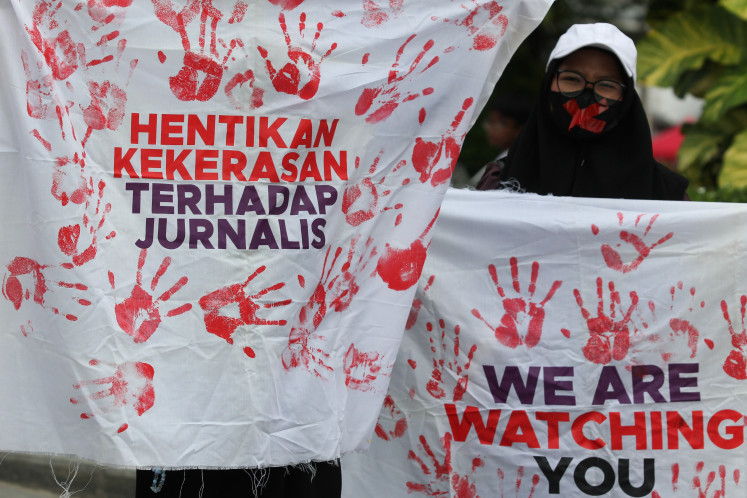Popular Reads
Top Results
Can't find what you're looking for?
View all search resultsPopular Reads
Top Results
Can't find what you're looking for?
View all search resultsJakarta will (not) submerge?
What are the real ongoing and continuing environmental problems facing Jakarta? The academic answer is the carrying capacity that is no longer able to support the continuing increase of population
Change text size
Gift Premium Articles
to Anyone
W
hat are the real ongoing and continuing environmental problems facing Jakarta? The academic answer is the carrying capacity that is no longer able to support the continuing increase of population.
This is because the city with an area of 662 square kilometers is poorly planned and managed so it is not able to accommodate its fast growing population demand for services. Hence, the city contributes pressure to the environment beyond its limited carrying capacity.
One of its essential resources for the city carrying capacity is water resources. What are the problems related with the water resources? First, we view it from water resources stressful aspect that is the increasing capacity of runoff, especially the effect of climate change, which creates climate anomaly and the degradation of water storage capacity, and infiltration of the soil, which extends from the upstream area to the Jakarta area itself.
The real impact of all these phenomenon is the flooding and stagnant water that occurs almost every rainfall (in the upstream area as well as within the city itself). Stagnant water and flooding are the real paralyzing cause for the city’s chaotic and extreme traffic congestion. This situation is exacerbated by the condition of a dilapidated drainage infrastructure system (it was designed some 30-40 years ago).
More ironically, almost all of the drainage canals are no longer properly functioning because they are mostly covered by buildings and piles of sediment and solid waste.
The second issue is the limited resources to meet the city’s water demand, especially clean piped water to meet the city water needs. This creeping problem has been linked to the serious urban ecological issue that is currently receiving public attention, particularly after the collapse of Jl. RE Martadinata in North Jakarta. What are the causal relations of land subsidence and the limited supply of clean piped water?
A very limited piped water service coverage ratio, which is only able to supply about 44 percent of the total Jakarta water demand, along with a very high water tariff (presently averaging Rp 7,400 per cubic meter), excessive groundwater abstraction occurs especially by commercial entities (hotels, apartments, malls, office buildings and industries).
The massive groundwater exploitation exceeding its natural recharge capacity has continually caused the lowering of a deep groundwater table and eventually causing land subsidence in many locations in the city.
On the other hand, the city also has to face the rising sea water level due to global warming. These two phenomena will threaten the city’s livable future, because some part of the urban area will likely submerge permanently if there is no technology, policy as well as social engineering intervention provided to mitigate the causes.
What are the available solutions for this very basic and essential urban problem? First is the need to rehabilitate and improve the whole city’s drainage networks system starting from the micro, collector and macro drainage systems.
Second, is the need to control the runoff by maximizing the water infiltration and retention (storage capacity) on land surface through the construction of ponds, lakes, dams, as well as underground water storage (reservoir), which in turn could also be used as additional raw water sources for the Jakarta-owned water supply company (PAM Jaya).
Third, it is to restrict immediately the deep groundwater exploitation by adequately supplying clean piped water, and of course with affordable water tariffs. Adequately provided clean piped water can only be done by increasing the supply of raw water for processing.
In the condition that none of the rivers can be utilized due to pollution, increase the supply of clean piped water can only be carried out by first, reducing the water leakages, and second, by building a potable water supply provision system at Jatiluhur area, which originally was studied and proposed by the Jakarta Water Supply Regulatory Body.
Fourth, while awaiting completion of the Jatiluhur water supply system project, the business communities should be encouraged and obliged to carry out their domestic wastewater reclaimation measure in order to convert it into clean non-potable water. This measure would reduce the reliance on groundwater utilization as well as clean piped water for their water demand, whereas at the same time also reduce the amount of wastewater discharge into the water bodies.
Fifth, for a long-term perspective, we must revitalize all existing open water bodies such as rivers, streams, ponds and dams in order to make them suitable raw water sources for PAM Jaya and at the same time also provides city ammenities just as in other developed cities in the world provides its quality of life (as also mentioned in the Bible and the Koran that potrays heaven with streams and rives flowing).
All of these, of course, would need considerable investment, but the risks are much more costly when they become disasters, and at that time we would have little opportunity to make the necessary restorations.
The writer, a lecturer and researcher at the Environmental Engineering Department, the University of Indonesia, is founder of the Indonesian Water Institute and a member of Jakarta’s Water Resources Council.










